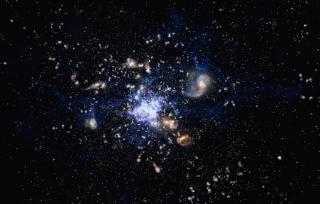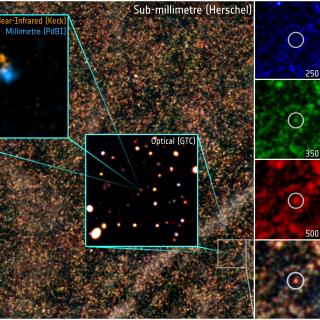Bibcode
Fudamoto, Y.; Oesch, P. A.; Walter, F.; Decarli, R.; Carilli, C. L.; Ferrara, A.; Barrufet, L.; Bouwens, R.; Dessauges-Zavadsky, M.; Nelson, E. J.; Dannerbauer, H.; Illingworth, G.; Inoue, A. K.; Marques-Chaves, R.; Pérez-Fournon, I.; Riechers, D. A.; Schaerer, D.; Smit, R.; Sugahara, Y.; van der Werf, P.
Bibliographical reference
Monthly Notices of the Royal Astronomical Society
Advertised on:
5
2024
Citations
17
Refereed citations
14
Description
We present results of dust continuum and [C II]$\, 158\, {\rm \mu m}$ emission line observations of a remarkably UV luminous (MUV = -21.6) galaxy at z = 10.603: GN-z11. Using the Northern Extended Millimeter Array (NOEMA), observations have been carried out over multiple observing cycles. We achieved a high sensitivity resulting in a $\lambda _{\rm rest}=160\, {\rm \mu m}$ continuum $1\, \sigma$ sensitivity of $13.0\, \rm {\mu Jy \, beam}^{ -1}$ and a [C II] emission line $1\, \sigma$ sensitivity of $31\, \rm {mJy\, beam^{ -1}\, km \, s}^{ -1}$ using $50\, \rm {km \, s}^{ -1}$ binning with a $\sim 2\, {\rm arcsec}$ synthesized beam. Neither dust continuum nor [C II]$\, 158\, {\rm \mu m}$ line emission are detected at the expected frequency of ν[C II]$= 163.791\, \rm {GHz}$ and the sky location of GN-z11. The upper limits show that GN-z11 is neither luminous in LIR nor L[C II], with a dust mass $3\, \sigma$ limit of ${\rm log}\, (M_{\rm dust}/{\rm {\rm M}_{\odot }}) \, \lt\, 6.5-6.9$ and with a [C II] based molecular gas mass $3\, \sigma$ limit of log (Mmol, [C II]$/{\rm {\rm M}_{\odot }}) \, \lt \, 9.3$. Together with radiative transfer calculations, we also investigated the possible cause of the dust poor nature of the GN-z11 showed by the blue colour in the UV continuum of GN-z11 (βUV = -2.4), and found that ≳3 × deeper observations are crucial to study dust production at very high-redshift. Nevertheless, our observations show the crucial role of deep mm/submm observations of very high-redshift galaxies to constrain multiple phases in the interstellar medium.
Related projects

Molecular Gas and Dust in Galaxies Across Cosmic Time
Two of the most fundamental questions in astrophysics are the conversion of molecular gas into stars and how this physical process is a function of environments on all scales, ranging from planetary systems, stellar clusters, galaxies to galaxy clusters. The main goal of this internal project is to get insight into the formation and evolution of
Helmut
Dannerbauer

Formation and Evolution of Galaxies: Observations in Infrared and other Wavelengths
This IAC research group carries out several extragalactic projects in different spectral ranges, using space as well as ground-based telescopes, to study the cosmological evolution of galaxies and the origin of nuclear activity in active galaxies. The group is a member of the international consortium which built the SPIRE instrument for the
Ismael
Pérez Fournon